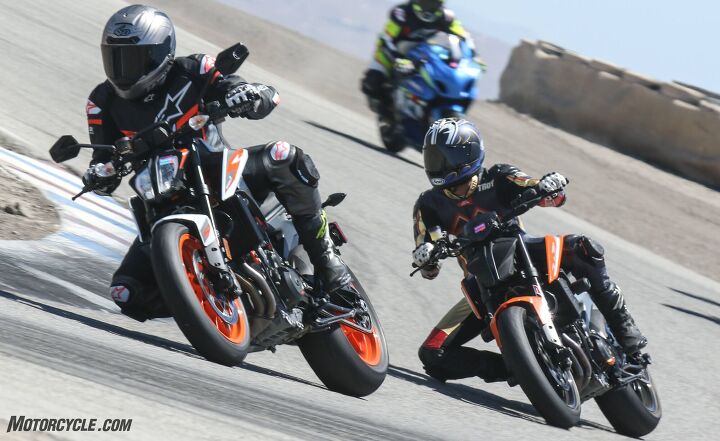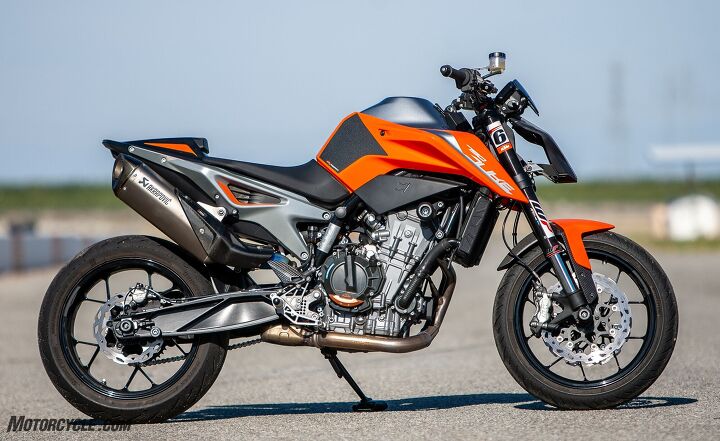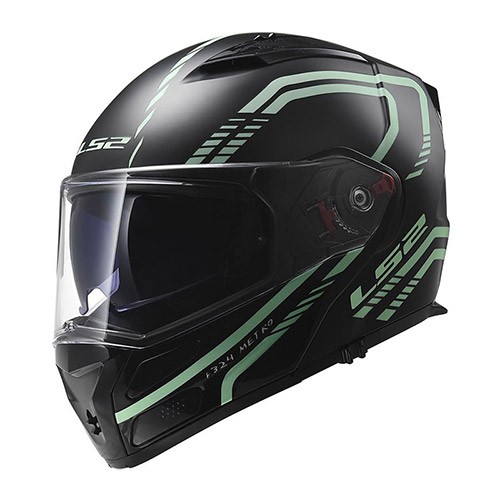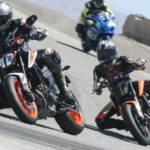
By now, my ongoing relationship with my 2019 KTM 790 Duke is possibly one of the most documented motorcycle love affairs of recent history. That’s okay. I can live with the ribbing from my coworkers. If that’s all they can think of to tease me about, I’m coming out way ahead in the game. Still, they have a point. I bought my 790 fully expecting that there would be a Duke R in the upcoming model year or two. I just didn’t expect it to have an 890 in front of it.
So, it naturally begs the question: Was all that time, effort, and money I spent building my own R-model with KTM PowerParts and the aftermarket wasted? Since we had the 890 Duke R and the Triumph Street Triple RS scheduled for a track day, I figured that the boys could spare a session each to throw a leg over my 790 and give me their impressions of how it stacks up to the 890.
KTM 790 Duke Project: Building A 790 R
2020 KTM 890 Duke R – First Ride Review
Blindsided
From the moment the 890 was announced, I knew that my little 790 would never be able to compare when it came to the engine. That’s not really a problem for most of the riding I do, but I figured that on the track, it would be a game-changer. Still, I’d be a liar if I didn’t say that my first ride of the 890 on our favorite mountain test road didn’t have me shaking my head in disbelief at the exit of every corner as I rolled the throttle open and the acceleration pushed me rearward. The power is that good, but I wondered if the boys would think I was in denial when I said I preferred the updated fueling (thanks to a Dynojet Power Commander V and a Rottweiler Power Plate) of my 790. The throttle is much more tractable.

Read it and weep, 790 owners. Despite the relatively low resolution, the graph shows how much smoother the 790’s power delivery is compared to the 890.
I turned out to be right on both counts. First, Ryan Adams and Troy Siahaan did accuse me of being in denial about my 790’s power delivery. However, I had the last laugh after they took their track sessions on the 790. Troy took the first stab at my 790 while I was on the 890, and he chased me around Buttonwillow Raceway for most of the session until he couldn’t resist showing how much faster he is than me – even on a slower bike.
The engines, according to Troy: A few things stand out to me between the 790 “R” and the 890. The first realization was that, despite the smaller engine, the 890 really only pulled away from me from the mid- to upper-sections of the rev range. But once it started pulling away, the gap got bigger in a hurry.
The big surprise, to me, was how much of a difference the Power Commander made. It wasn’t until I rode your bike that I fully understood how much worse the stock fueling is on the 890. It was hard to ignore each time I rode the 890 after that. The re-map results in noticeably more linear power delivery and any on/off throttle hiccups were all but eliminated. I’d be curious to try this comparison again on the street to see the difference in a more “real world” setting. [Unfortunately, the 890, being in hot demand, had to be sent back to KTM before we could do this. – EB]

Some credit for the 790’s smooth power delivery goes to the pairing of the Rottweiler Power Plate and the Dynojet Power Commander V.
Ryan concurred, even going so far as to say that the session influenced his decision in the 890/STRS comparo: Troy and I both knocked the 890 for its less than stellar fueling. It was one of our main complaints with the bike. If I hadn’t had the chance to ride Evans’ PC V-equipped 2019 790 Duke (with a custom fuel map) to experience just how smooth the throttle could be, it would have made the decision between those two great bikes even more difficult.
My summation: Yes, I prefer my 790 R’s massaged fueling anytime that I’m modulating the throttle, but what’s that they say about power? Oh yeah, it’s corrupting – and the acceleration provided by the 890’s updated engine is clearly a tool of the devil. Each time the power knocked my ass back into the seat pad, I thought about all the terrible, awful, no good, very bad things I could do with an 890 parked in my garage. Still, I’ll call this category a tie because this is my article, and I can. Outright power goes to the 890, but the 790 delivers it better. I’m a finesse over brute force rider, anyway.
Size Matters
All of the speed that the engine creates, brakes are put on this planet to destroy. It’s the circle of life. And holy crap, what a revelation the 890’s binders were! I was dumbfounded the first time I clamped down on the 890’s lever at Buttonwillow. Then on the next big braking corner, I hammered it again, and again on the next lap. While the 790 (in its current setup with the Brembo 19RCS Corsa Corta master cylinder) offered the same level of power and feel at the lever, the difference in sheer braking force delivered by the 320mm discs had me foaming at the mouth by the time I returned to the pits. I was reduced to nothing but expletives when describing the 890’s brakes. Ryan and Troy laughed at me, and I almost didn’t notice.

The additional leverage that the 320mm discs offer the 890 Duke R rider can’t be understated.
So, what did the boys say? Troy’s notes: Upgrading your master cylinder to the Corsa Corta was a good call. I don’t remember what the stock 790 lever felt like, but I vaguely recall it was decent, at best. The upgrade brings it on par with the 890, in my opinion (with the MCS of the 890 maybe a fraction better), but the difference in rotor size is hard not to notice. Personally, along with the bigger rotor, I’m also of the belief (though I really don’t have anything to back me up on this) that having plain, round rotors instead of wave discs gives you more surface area for the pads to create friction and slow you down. Whereas wave discs might give more of a biting surface, but less overall surface.
Ryan follows with: Brembo Stylemas. Is there really anything else to say? The top-shelf Brembo calipers and MCS master cylinder combined with the larger rotors on the 890 deliver braking performance on an entirely different level while also providing excellent adjustability. Evans’ upgrades to the 790’s braking system certainly give more feel at the lever than the stock components, and the adjustability of the Brembo 19RCS Corsa Corta unit is welcome. Without riding a stock 790 back-to-back with his, it’s hard for me to say just how much. What is clear is that, in my opinion, the 890’s stopping performance is still a step above.

Yes, the PowerParts/Galfer Wave Discs are better – and lighter – than the OEM discs, but at 300mm, they can’t compare to the 890’s 320mm rotors.
OK, I’d admit that the 890 Duke R clearly wins this round – even if I didn’t have Ryan’s and Troy’s comments. Why? Because I find myself thinking…late at night…when I’m lying in bed pondering the next track day…that a set of Galfer 320mm discs are only a little more than $600. And who can put a price on happiness? Or braking power? No, I don’t need Stylemas. Really, I don’t…
Battle of the Boingers
The most profound change I made to my 790 R was to upgrade the non-adjustable stock suspension to WP Apex Pro units front and rear. While the OEM bits offered a good compromise for the wide variety of things that riders around the world will do with their 790 Dukes and though they were capable of running at an elevated pace in the mountains and at the track, they were clearly out of their happy place, allowing excessive chassis movement. I was extremely interested to see how the suspenders on the 890 (which are classified between the stock 790 and the WP aftermarket ones) performed on a closed course. And after my 890 session, I felt that my Apex Pro suspension worked better. However, the difference wasn’t extreme, and I wondered if it was just because I’d spent time dialing in the compression and rebound damping to my preferences.

The preload function is only available on the WP aftermarket fork cartridges.
Troy put my fears to rest: I’d say the better suspension on your 790 made a difference, but only one you’d feel if you were paying close attention, riding the two back-to-back. It’s better at dealing with mid-corner bumps. If I were paying that kind of money, I’d probably keep the standard 890 suspension and opt for lighter wheels. If you have a 790, then definitely, a suspension upgrade of some kind is worth the expense.

Both Troy and I agreed that the 790’s WP Apex Pro suspension handled mid-corner bumps better than the 890’s slightly lower spec WP Apex items.
Ryan opines: The 890 Duke R’s 43mm WP Apex suspension offers the adjustability so many had yearned for on the 790. And it works quite well. Evans’ upgrade to the Apex Pro units on the 790 was one of the first mods he did, and I can’t blame him. That being said, after putting his 790 and the 890 back to back for a few short laps around Buttonwillow Raceway, I didn’t have much to say about the difference between the two. Maybe it was the few laps I had on the bike, but there certainly wasn’t a night and day difference between the two, in my opinion.
I’d even go a step further than Troy and say that if you took the 890 to a good suspension shop, they could probably get it set up pretty dang close to how the WP Apex Pros worked. If you have a 790 and like to ride on the track, get yourself to a WP service center. Advantage, by a hair, 790 R.
Well Positioned
One area that I didn’t expect to be a topic of discussion in a comparison between the 790 and 890 Dukes was the riding position. While I’ve been gradually massaging the 790’s riding position from the day I put my name on the title, I looked at it more as setting up the bike to my preferences – you know, like adjusting clutch and brake lever angle and distance from the bar. However, for Ryan, the 790’s riding position has always been an issue.

Ryan’s discomfort with the 790 on the track is likely caused by the highness of the grips.
Said Ryan: A major sticking point for me between the 790 and 890 Dukes is the riding position. Thankfully, this can be tweaked relatively easily. At the track, I never really meshed with the 790. After riding the 890 with its wider flatter bars and higher footpegs, I determined quickly that my discomfort was mostly down to the ergonomics. On the street, both models feel fine, but the 890 Duke R’s setup was my preference for track days despite the 790’s aftermarket footpegs – which I found a little short in length and not in the right position for my liking (though they offer plenty of adjustment).
Troy, on the other hand, said that he noticed the difference, but it didn’t really make a difference for him.
Still, Ryan’s got a point. When he rode the 790, I’d already moved the handlebar risers to their forward position and rotated the bar in the clamps towards the front of the bike to give a slightly more aggressive riding position. I’ve got the PowerParts rearsets in their highest and most rearward location, and they’ve ended my toe-dragging problem at track days without making street rides less comfortable. On the street, the riding position feels pretty good to me, but the 890 handlebar has just a little bit better position. Consequently, this past weekend, I installed an 890 bar on my 790, and I’m anxiously awaiting my next track day. (I know, I am weak.)

Note how much lower my hands are in this photo compared to Troy’s in the one above. While it doesn’t make much difference on the street, the 890’s handlebar bend is more suited to track mode.
Grudgingly, I’ll give this round to the 890 for being better out of the box, but I still see myself fitting the PowerParts rearsets and moving the risers to their forward position if it were my bike.
The Checkered Flag
Loyal MO readers would rightfully cry foul if I claimed that my 790 R was better than the stock configuration of the 2020 KTM 890 Duke R – particularly when you factor the final price into the equation. With the inclusion of the updated engine, KTM altered the landscape of what the Super Scalpel would be. The upgraded brakes and suspension are right in line with what one would expect for an up-spec R model. The kick in the nuts, though, is the insanely low price – even when the additional electronics packages are tacked on to the MSRP. So, not surprisingly, the 890 Duke R wins when compared to a 790 Duke upon which I’ve lavished $4,783 worth of performance upgrades.

And the winner is: the 2020 KTM 890 Duke R. The combination of its impressive brakes and more powerful engine puts it head-and-shoulders above my modified 790 “R”.
Still, I’ve got a lot to be happy about despite all the effort and money I’ve spent on my bike. First, I’ve had the fun of creating a bike that suits my particular desires. After the hundreds of bikes that have been through my garage in my time as a motojournalist, my wife takes great pleasure in pointing out that I can’t walk past the 790 without touching it or squeezing the front brake lever. She thinks it’s cute, my affection for this machine, after a career devoted to riding every motorcycle possible. So, I get razzed at home and at work, and you know what? It doesn’t bother me at all. They’re just jealous that I’m having so much fun.

Being number two isn’t all bad when you consider the company.

